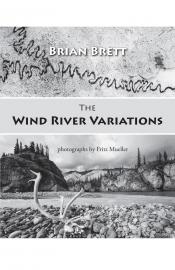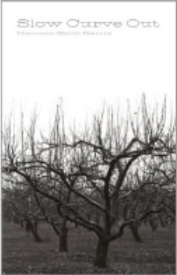Reviews
Poetry Review by Candace Fertile
Brian Brett, photography by Fritz Mueller, The Wind River Variations (Fernie: Oolichan, 2012). Paperbound, 96 pp., $22.95.
Maureen Scott Harris, Slow Curve Out (Toronto: Pedlar, 2012). Paperbound, 96 pp., $20.

Canadian poets and nature are often a good fit, and two recent collections demonstrate the felicity of the combination. Brian Brett’s The Wind River Variations and Maureen Scott Harris’s Slow Curve Out take different approaches to wilderness, and each delivers thought-provoking poems full of strong imagery.
Brett’s collection is the result of a 2003 Wind River expedition made under the auspices of the Canadian Parks and Wilderness Society. The trip was one of several to introduce a variety of artists and naturalists to the Three Rivers watershed (Wind River, Snake River, Bonnet Plume River) in the hope they would produce work that “would naturally ripple outwards, and expand into the general culture,” as Brett notes in the Acknowledgments. In the group was Fritz Mueller, whose black and white photographs add another dimension of artistry to this volume. “Cowboys of the Near-Arctic” is a long poem that shows Brett’s strengths beautifully. The conjunction of narrative and imagery starts with the sound of horse bells that take the poet back to a trip to China in 2000. The prayer bells and horse bells create an aural image of peace and meditation, broken in both worlds by violence:
That’s right, remind me I’m in the temple
and the cultural revolution is hammering
on the gates. I can still hear
the bones breaking under the tanks.
[ … ]
the whisper
of a bullet
above the grass, the cool cool air
ahead of dying, the authority of technology,
the thrill in the stutter of the heart when the ancient ur-bear
crosses the smoking river.
For Brett, human beings are generally destructive and mistaken, although he pays great respect to the guides on the expedition, members of the Nacho N’yak Dun and Tetlit Gwich’in tribes, whose traditional territory is the Peel watershed. Underlining several of Brett’s poems is the fact of aging. In “Lining the Canoes,” for example, he asks, “How do we dance?” and offers his own eloquent answer: “We leap the gap, we embrace the air, we push space” while noting that his “ruined knees” make physical activities a challenge. In the prose poem “Calling the Caribou” he recalls his past adventures in the wilderness and the wrecking of his knees hauling huge packs up and down mountains. With humility he admits, “I thought I knew wilderness, but it was only as I watched it disappear that I realized I never understood where I had been.” The piece goes on to describe how Jimmy Johnny calls the caribou: a series of moves entices a faraway animal to come close to inspect. And in a moment of poetic justice, Brett slyly includes the befuddled response of a professor who had been lecturing a young woman about the “myth” of calling the caribou once he hears about Jimmy’s ability. Humour makes an appearance, but it’s a wry humour. In “The Complaining Grouse,” a grouse, “young hoodlum of a bird,” protests the invasion of his world by aliens and keeps the poet awake at night: “But complaining too much / can also invite the uncomplaining” and as the poem shows, life in a harsh climate is often dealt with harshly.
A few poems do not match the excellence that Brett has set in this
collection. “Wind River Blues” plays on the colour blue in predictable
ways. “Blue of a robin’s egg” or “blue as a baby boy’s traditional blanket”
are tired images. Fortunately such missteps are few in this book.
Overall, Brett’s language is accessible and inviting. He recreates a
world that few of us will ever get to see (and maybe the fewer people
who go there, the better?). His love of wilderness and dislike of cities
(and city people) comes across clearly. In a Postscript, he explains
“what we learn” and tells a remarkable story about his encounter with
wolves. In what is almost typical fashion for Brett, he excoriates himself
for his reaction to the animals although it’s hard to believe that
most of us would not do the same. For him, the experience is a
reminder that “we no longer live in the wilderness, we only visit the
wilderness.”

Maureen Scott Harris’s interest lies in nature more generally than in a specific wilderness. Harris quotes from Alexander Wilson at the beginning of her volume, and the quotation can apply equally to Brett’s book: “the wall between humans and the natural world is not an absolute. It is permeable, shifting, able occasionally to be leaped over.” Both books open with poems alluding to other poets: Brett’s to Baudelaire in “Invitation to the Voyage” and Harris’s to Rilke in “Walking in Saskatchewan with Rilke.” Perhaps it’s an essential contradiction to celebrate nature (especially the wilderness) and the written word, but I’m glad these poets have done it. Harris’s book is divided into three parts: “Back up, Begin Again,” “The Ten Thousand Things,” and “Another Animal.” While most of the poems are short, two long ones stand out: “Epistemology: The World Speaks” and “Walking Ghazals.” “Epistemology” is in eleven parts and is in memory of Alexander Wilson, “horticulturist, landscape restorer, writer.” Wilson’s view of nature is given: “He’d spoken of nature being—not poems, not gardens, / not life lists or tree books—beyond what we know. His words opened / a space in my head, and everything rearranged.” In “Epistemology: The World Speaks,” Harris looks at farms, a subject likely more familiar to readers than remote wilderness areas: “On the dusty prairie farm I watched the great beasts / lumbering and sliding down the edges of dugout / to drink—angular hips punching up beneath / red-brown skins as if they might poke through, / bags of bones, awkward and undulant, glowing in the sun, / the grass they chewed greeny-brown.” “Walking Ghazals” is a loose interpretation of the ghazal form. Harris follows the guideline of having each couplet autonomous, but she is more open with the meter and line length than the traditional ghazal form suggests. The content is classic ghazal—metaphysical questions, for example, “Lost on the road, lost in the bush, lost in thought— / Which of these does not belong?” Harris includes elements of the haiku with rich imagery and turns: “Each day, blister and a checkmark on the calendar. / The pointless endlessness of it all.” While Harris’s poems are mostly fixed in the sensory world, she uses that world as a place to jump into philosophical inquiry.
The short poem is handled deftly by Harris. “Animal Lives of the Poem” uses a word that recurs in her poetry: “arcs.” In the third part of this five-part poem, the speaker says, “Calling faintly from trees a street away / the poem arcs close and, crest rising, / veers raucous over you. / All the small lives you hoped / to surprise scatter.” Firm control of line length is evidenced by this poem, along with a gentle sense of humour, but all the poems are deeply controlled and most are quite serious in tone.
Brett and Harris share some concerns about nature, and obviously both are aware of its essential contribution to human life. These volumes present divergent ways of considering nature and, in that regard, reflect a small part of the massive variance in the natural world.
—Candice Fertile









